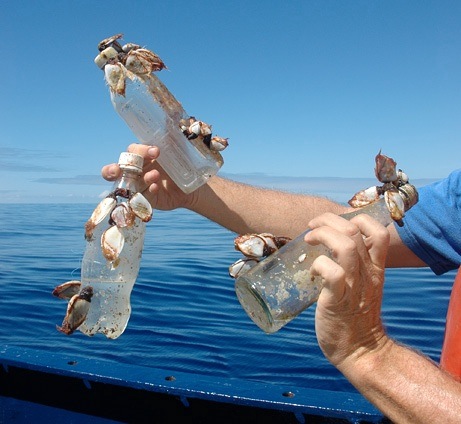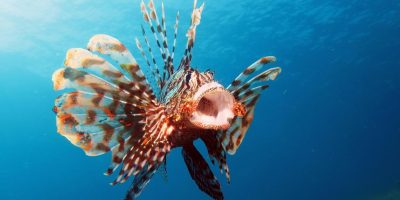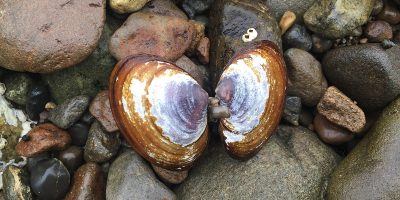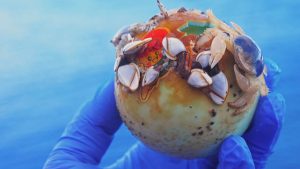We have explored the major implications of our changing climate on ecosystem health and the success of global fisheries over the last several weeks, and have heard about many of the threats that face our oceans and the ways in which they impact society. One that particularly piques my interest is the spread of invasive species and its implications for society and communities, including fisheries management and ecosystem health.
Plastic: the perfect vessel
The transportation of marine invasive species from one ecological niche to another can cause colossal damage in already delicate ecosystems, sometimes wiping out entire species or transforming entire communities. There are many ways in which species are moved from one coastal environment to another. Transfer may happen via boat: in ballast water or on the hulls of ocean-going vessels. Historically, species were primarily introduced to new environments by hitching a ride on natural forms of floating debris like wood, algae mats, and pumice. Nowadays, plastic makes a near perfect vessel for all sorts of invasive species because of its buoyancy and resistance to degradation. Bacteria, viruses, larval fish, mollusks, anthropods, and bivalves are all being introduced to new habitats around the world and negatively impacting ecosystems (Gallardo et al. 2015). The astonishing increase in plastic debris in the ocean is devastating for many reasons, but its unique characteristics that help invasive species spread make it especially dangerous.
Floating rafts of plastic
Most of the plastic that ends up in the ocean breaks down into smaller particles due to corrosion and UV rays. However, due to the constant influx of land-based litter (intentionally or unintentionally dumped into the ocean), there is no shortage of large plastic debris. Although all plastics are susceptible to becoming hosts for invasive species, these floating “rafts” of large plastic accumulate a variety of species and concentrate of biofouling organisms. Depending on their original physical size, location, surface type and material, rotational stability, and density, these plastic floating rafts can have significant impacts on the ocean ecosystem (Goldstein et al. 2014).
For example, rafts that are nearshore may accumulate more biomass than those further offshore. Floating debris that is made of a rough substrate as opposed to those with smooth surfaces may be more habitable, and similarly a larger and more stable raft is likely to accommodate a higher concentration and diversity of species. Larger plastics are likely to be more buoyant and stable, and therefore accumulate a higher biomass (Goldstein et al. 2014). Plastics that are heavier or weighed down by biofouling may not be transported as far, or may not be habitable to species that require sunlight. Further, heavy rafts that become more buoyant as they degrade will be exposed to more sunlight, effectively killing whatever species were using it (Rech et al 2016).
The negative impacts of invasive species
Invasive species can influence specific native taxa or species groups directly by introducing new competition or a new predator. They can also have an indirect impact by changing the composition of a habitat. Depending on their position in the food chain, invasive species change the species diversity and abundance from both a top-down and bottom-up perspective. A small change in the species composition at one trophic level can have ripple effects throughout the entire ecosystem, causing habitat loss, changes in diet, and eventually extinction of native species.
However, the impacts can be complicated. One study found that the introduction of invasive species negatively influenced species abundance, but species diversity did not decline (Gallardo et al. 2015). This suggests that invasive species pose an immediate threat to abundance in a community, but there is a lag time after the introduction of a new species before changes begin to take place and the success of a population is threatened (Gallardo et al. 2015).

Figure 1. Characteristics of species found on rafts of plastic; a) number of each taxa found on floating plastic debris, b) number of taxa by feeding group, c) similar numbers of mobile and sessile taxa, d) a surprising number of taxa (> 25) that had not been previously associated with rafting communities. This could have a lot of implications, many of which require much more research. Figure from: Goldstein et al (2014).
Aquatic invasive species pose a threat to many species that have a direct effect on humans. The majority of the species being transported on plastic rafts are suspension feeders (Fig 1b), and the introduction of these filter feeders has the largest direct impact on planktonic communities (Gallardo et al. 2015). This may have an extremely damaging impact on fish populations, consequentially negatively impacting fisheries. With few exceptions, rafting species are most commonly introduced into coastal ecosystems like reefs, mangroves, or wetlands, which are also the most diverse and productive in terms of fisheries (Havel et al. 2015).
There are currently very few feasible solutions to plastic pollution in the ocean, and although many efforts have been made, few have made a significant dent in the huge accumulation of plastic litter. As we continue to work on tangible solutions, we must attempt to stop the problem at its source before it continues to grow. This means not only implementing policy that prevents corporations from allowing plastic waste to be leaked into the oceans, but also educating the public on the damage that it causes.
References and Further Reading:
Gallardo, B., Clavero, M., Sánchez, M. I. and Vilà, M. (2016), Global ecological impacts of invasive species in aquatic ecosystems. Glob Change Biol, 22: 151–163. doi:10.1111/gcb.13004
Goldstein, M.C., Carson, H.S. & Eriksen, M. Mar Biol (2014) 161: 1441. doi:10.1007/s00227-014-2432-8
Havel, J.E., Kovalenko, K.E., Thomaz, S.M. et al. Hydrobiologia (2015) 750: 147. doi:10.1007/s10750-014-2166-0
Rech, S., Borrell, Y., Garcia-Vasquez, E. (2016), Marine litter as a vector for non-native species: what we need to know. ScienceDirect







Leave a Reply